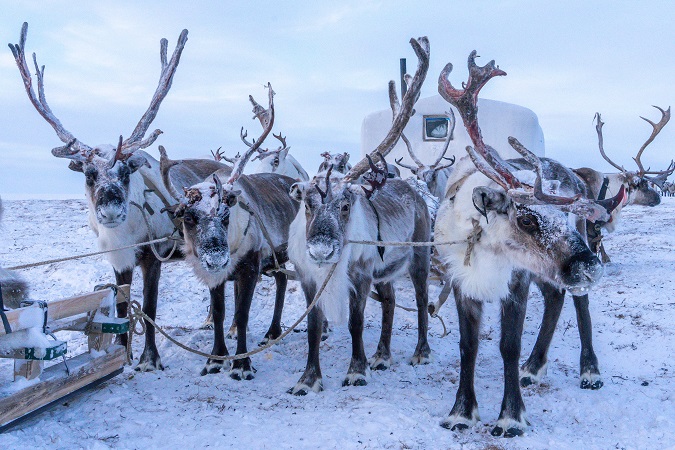
Reindeer are prominent in our holiday music and images. They pull Santa’s sleigh, have names, and can fly. But how much do you really know about this northernmost deer species?
Reindeer in North America are called caribou They are a species of deer that are found in the Arctic tundra and adjacent boreal forests of Greenland, Scandinavia, Russia, Alaska, and Canada. There are about 3.5 million caribou in North America and perhaps 1 million wild reindeer in Eurasia, with most of them in Russia. Nearly 3 million domestic reindeer live in northern Europe.
Large males can stand nearly 4 feet tall at the shoulder and exceed 550 pounds in weight; females are slightly smaller. Reindeer have deeply cloven hoofs so the feet can spread on snow or soft ground; they are also good swimmers. Color varies from whitish in winter to brown in summer. Heavy guard hairs are hollow, which increases the coat’s insulating properties. Antlers with up to 44 points can grow to 4 ½ feet long in males; this is the only deer species in which females also have antlers. Their lifespan is about 15 years in the wild and 20 in captivity.
There are two varieties: tundra reindeer and forest (or woodland) reindeer. Tundra reindeer migrate between tundra and forest in huge herds numbering up to half a million in an annual cycle covering as much as 3,000 miles. Forest reindeer are much less numerous.
Eurasian and American forest reindeer live in family groups of 6 to 13, with seasonal ranges of 190 square miles or less. Tundra reindeer spend winter dispersed in forests but gather in the spring to migrate onto the tundra; in fall they mass again to return to the forest. Summer food is grass, sedges, green leaves of shrubs and new growth of larch, willow, and birch; mushrooms are sought in late summer. In winter, their metabolism slows, and reindeer rely on high-carbohydrate lichens called reindeer moss, which they reach by digging craters in the snow. The reindeer survive on this low-protein diet by recycling urea (normally a waste product) within the digestive system and making use of its nitrogen. Females keep their antlers all winter, which enables them to defend feeding craters from each other as well as males, which shed their antlers soon after the rut.
Here are 12 fascinating facts you can use to impress your friends and family:
- In North America reindeer are also called caribou.
- Both the males and females grow antlers.
- Their noses are specially designed to warm the air before it gets to their lungs.
- Reindeer hooves expand in summer when the ground is soft and shrink in winter when the ground is hard.
- Some subspecies have knees that make a clicking noise when they walk so the animals can stay together in a blizzard.
- Some North American caribou migrate over 3,000 miles in a year – more than any other land mammal.
- Though thought of as a tundra species, a form of caribou lived in southern Idaho until the 19th century (there are ongoing efforts to re-establish them in the state).
- Northernmost species are much lighter in color than species at the southern end their range.
- Reindeer have been herded for centuries by several Arctic and Subarctic peoples.
- The name “reindeer” is of Norse origin (from the old Norse word “hreinn” for deer) and has nothing to do the reins of a sled. The name “caribou” comes to us through the French, from the Mi’kmag “qalipu,” meaning “snow shoveler.”
- Golden eagles are the leading predator of caribou calves in the late spring and fall.
- Once the entire body of a reindeer was found inside a Greenland shark (most likely a case of near-shore scavenging, as opposed to a migrating land shark).
Measure for measure, reindeer are incredible creatures both in the wild and when they are pulling Santa’s sleigh.
Related Articles & Free Email Newsletter Sign Up
How to Avoid Holiday Hazards for Pets


Comment here